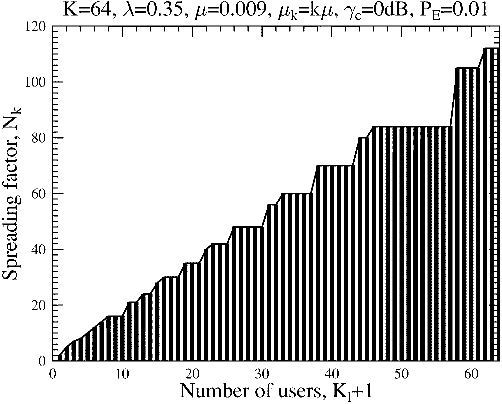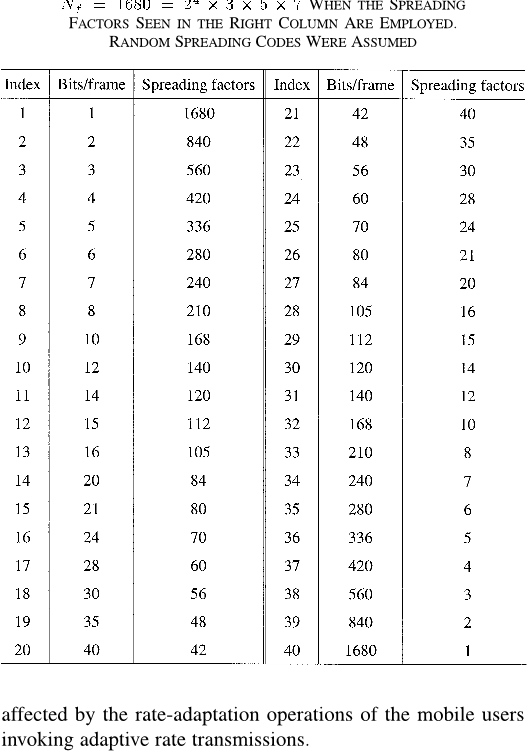




Did you find this useful? Give us your feedback
















11 citations
5 citations
...Variable Spreading Factor is a technique that attempts to increase the average throughput of the system by switching between spreading codes with different spreading factor, depending on the quality of channel [6-8, 11]....
[...]
4 citations
...For instance in [17], the use of variable spreading factors (VFSs) to adapt the transmission rate to the level of multiple access interference (MAI) in order to improve the achievable throughput is studied....
[...]
4 citations
...In particular, the failure of the handshaking phase is due to the collision of RTS/CTS packets from different nodes or to the Multiple Access Interference (MAI) due to the active nodes that are transmitting with other codes....
[...]
...On the other hand, a higher spreading factor means a communication at a lower data rate and lower vulnerability guarantees to MAI....
[...]
...It is important to note that a low spreading factor value allows communication at higher data rate but it gives rise to a higher vulnerability to the MAI....
[...]
...Moreover an adaptation rule for the spreading factor selection of the RTS/CTS packets has been used; the proposed scheme help to select the optima spreading factor value in order to minimize the Multiple Access Interference (MAI) [6] between contemporaneous transmissions and the collision of those packets, adapting to the actual network congestion state....
[...]
...Moreover an adaptation rule for the spreading factor selection of the RTS/CTS packets has been used; the proposed scheme help to select the optima spreading factor value in order to minimize the Multiple Access Interference (MAI) [6] between contemporaneous transmissions and the collision of those packets, adapting to the actual network congestion state....
[...]
3 citations
[...]
5,048 citations
...In order to combat the MUI in DS-CDMA systems, as we have mentioned above, the most efficient approach is to use multiuser detection receivers [7]....
[...]
...The most efficient technique of combating the MAI is multiuser detection (MUD) [7]....
[...]
...In contrast to the conventional VSF-assisted adaptive rate-transmission scheme, where the transmission rate is adapted in response to the channel-quality fluctuation recorded at the output of the MUD [17], the transmission rate in the proposed scheme is adapted in response to the time-varying interference level due to the MUI, while maintaining the required target BER value....
[...]
...bating the MAI is multiuser detection (MUD) [7]....
[...]
...The main obstacle of employing DS-CDMA MUD receivers is, however, the high complexity of the multiuser detection algorithms....
[...]
2,355 citations
2,163 citations
...Another efficient technique of increasing the capacity of time-varying wireless channels is the employment of adaptive rate transmissions [8]–[12], in which the transmission rate can be adaptively adjusted according to the instantaneous channel...
[...]
1,723 citations
...Based on the above assumptions and assuming furthermore that there are active users (the reference user plus interfering users), then the received signal at the BS can be expressed as [18]...
[...]
...According to the analysis of [18], the bit errors in DS-CDMA systems communicating over AWGN channels are caused by the effect of multiple-access interference and the AWGN....
[...]
1,193 citations
...Hence, the multiuser interference level can be modeled as a discrete Markov process [14], which describes the number of active mobile users....
[...]
...where the probability of simultaneously supporting users is known as the Erlang B formula [14], which determines the call blocking probability of the system considered....
[...]
...1In theM=M=m=m queueing system [14], the first parameterM indicates that the arrival process is a Poisson process, the second thatM indicates that the service time obeys a negative exponential distribution, the third thatm quantifies the number of servers, while the last (m) indicates the limit of the number of customers in the system....
[...]
...Specifically, we consider the uplink transmission of a single-cell DS-CDMA system, where the number of active mobile users obeys the Poisson distribution [14] and all the signals transmitted by the mobile users are power controlled....
[...]
...1, which represents a queueing system [14]....
[...]